Related Research Articles
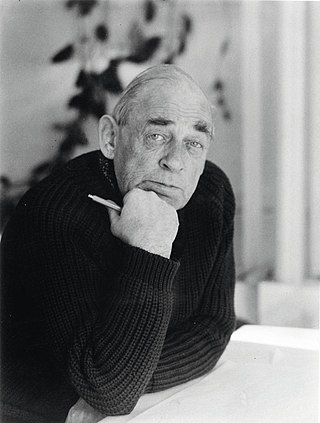
Hugo Alvar Henrik Aalto was a Finnish architect and designer. His work includes architecture, furniture, textiles and glassware, as well as sculptures and paintings. He never regarded himself as an artist, seeing painting and sculpture as "branches of the tree whose trunk is architecture." Aalto's early career ran in parallel with the rapid economic growth and industrialization of Finland during the first half of the 20th century. Many of his clients were industrialists, among them the Ahlström-Gullichsen family, who became his patrons. The span of his career, from the 1920s to the 1970s, is reflected in the styles of his work, ranging from Nordic Classicism of the early work, to a rational International Style Modernism during the 1930s to a more organic modernist style from the 1940s onwards.
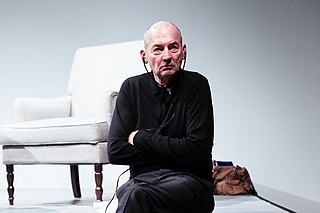
Remment Lucas Koolhaas is a Dutch architect, architectural theorist, urbanist and Professor in Practice of Architecture and Urban Design at the Graduate School of Design at Harvard University. He is often cited as a representative of Deconstructivism and is the author of Delirious New York: A Retroactive Manifesto for Manhattan.
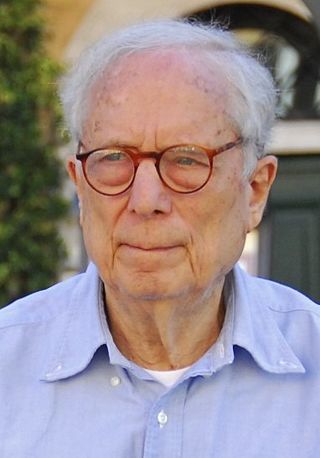
Robert Charles Venturi Jr. was an American architect, founding principal of the firm Venturi, Scott Brown and Associates, and one of the major architectural figures of the 20th century.
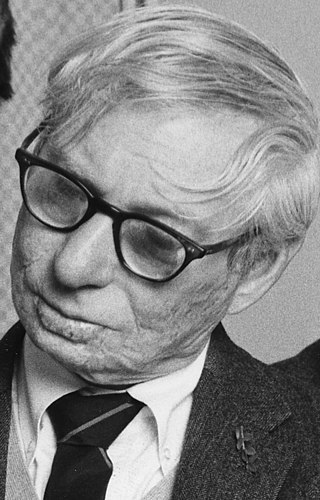
Louis Isadore Kahn was an Estonian-born American architect based in Philadelphia. After working in various capacities for several firms in Philadelphia, he founded his own atelier in 1935. While continuing his private practice, he served as a design critic and professor of architecture at Yale School of Architecture from 1947 to 1957. From 1957 until his death, he was a professor of architecture at the School of Design at the University of Pennsylvania.

The International Style or internationalism is a major architectural style that was developed in the 1920s and 1930s and was closely related to modernism and modernist architecture. It was first defined by Museum of Modern Art curators Henry-Russell Hitchcock and Philip Johnson in 1932, based on works of architecture from the 1920s. The terms rationalist architecture and modern movement are often used interchangeably with International Style, although the former is mostly used in the English-speaking world to specifically refer to the Italian rationalism, or even the International Style that developed in Europe as a whole.

Modern architecture was an architectural movement and style that was prominent in the second half of the 20th century, between the earlier Art Deco and later postmodern movements. Modern architecture was based upon new and innovative technologies of construction ; the principle functionalism ; an embrace of minimalism; and a rejection of ornament.
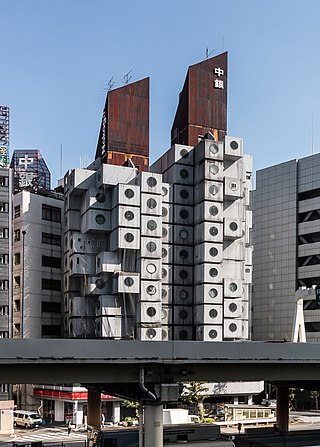
Metabolism was a post-war Japanese biomimetic architectural movement that fused ideas about architectural megastructures with those of organic biological growth. It had its first international exposure during CIAM's 1959 meeting and its ideas were tentatively tested by students from Kenzo Tange's MIT studio.

Mid-century modern (MCM) is a movement in interior design, product design, graphic design, architecture and urban development that was popular in the United States and Europe from roughly 1945 to 1969, during the United States's post–World War II period. The term was used descriptively as early as the mid-1950s and was defined as a design movement by Cara Greenberg in her 1984 book Mid-Century Modern: Furniture of the 1950s. It is now recognized by scholars and museums worldwide as a significant design movement. The MCM design aesthetic is modern in style and construction, aligned with the Modernist movement of the period. It is typically characterized by clean, simple lines and honest use of materials, and it generally does not include decorative embellishments.

Florence Marguerite Knoll Bassett was an American architect, interior designer, furniture designer, and entrepreneur who has been credited with revolutionizing office design and bringing modernist design to office interiors. Knoll and her husband, Hans Knoll, built Knoll Associates into a leader in the fields of furniture and interior design. She worked to professionalize the field of interior design, fighting against gendered stereotypes of the decorator. She is known for her open office designs, populated with modernist furniture and organized rationally for the needs of office workers. Her modernist aesthetic was known for clean lines and clear geometries that were humanized with textures, organic shapes, and colour.

Phillips Exeter Academy Library is a library that serves Phillips Exeter Academy, an independent boarding school located in Exeter, New Hampshire. It is the largest secondary school library in the world, containing 160,000 volumes over nine levels with a shelf capacity of 250,000 volumes.

Aino Maria Marsio-Aalto was a Finnish architect and a pioneer of Scandinavian design. She is known as a co-founder of the design company Artek and as a collaborator on its most well-known designs. As Artek's first artistic director, her creative output spanned textiles, lamps, glassware, and buildings. It has been discovered that it was Aino who completed the first work commissioned through Artek which was the Viipuri Library in 1935. Her work is in the permanent collection of the Museum of Modern Art (MoMA) in New York, and MoMA has included her work in nine exhibitions. Aino Aalto’s first exhibition was Art in Progress: 15th Anniversary Exhibitions: Design for Use at MoMA in 1944. Other major exhibitions were at the Barbican Art Gallery in London and Chelsea Space in London. Aino Aalto has been exhibited with Pablo Picasso.
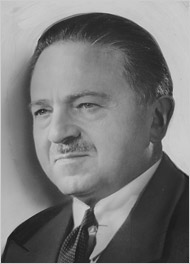
Ely Jacques Kahn was an American commercial architect who designed numerous skyscrapers in New York City in the twentieth century. In addition to buildings intended for commercial use, Kahn's designs ranged throughout the possibilities of architectural programs, including facilities for the film industry. Many of the buildings he designed under the 1916 Zoning Resolution feature architectural setbacks to keep the building profitably close to its permitted "envelope"; these have been likened to the stepped form of the Tower of Babel. Kahn is also known for his guidance to author Ayn Rand.

Deconstructivism is a postmodern architectural movement which appeared in the 1980s. It gives the impression of the fragmentation of the constructed building, commonly characterised by an absence of obvious harmony, continuity, or symmetry. Its name is a portmanteau of Constructivism and "Deconstruction", a form of semiotic analysis developed by the French philosopher Jacques Derrida. Architects whose work is often described as deconstructivist include Zaha Hadid, Peter Eisenman, Frank Gehry, Rem Koolhaas, Daniel Libeskind, Bernard Tschumi, and Coop Himmelb(l)au.
Robert E. Somol Jr. is an architectural theorist and was director of the School of Architecture at the University of Illinois at Chicago from 2007 to 2022. His writing has been centrally-linked to "post-critical" architectural theory at the turn of the 21st century; the concept is similar to that of postcritique found in literary criticism.
Włodzimierz Książek was a Polish-born contemporary artist based in New England, and since 2001 worked from a 6000 sq. ft. studio in Rhode Island. He was best known for his large-scale abstract paintings.
New Babylon is an anti-capitalist city perceived and designed in 1959-74 as a future potentiality by visual artist Constant Nieuwenhuys.
The estate Zonnestraal is a former sanatorium in Hilversum, the Netherlands. The building was designed by architects Jan Duiker Bernard Bijvoet and Jan Gerko Wiebenga, and is an example of the Nieuwe Bouwen. In 1995, the estate was submitted to UNESCO's list of World Heritage Sites, but it was ultimately not listed.
Anna Klingmann is a German born, American architect, author and academic who specializes in branding. She is the founder and principal architect of Klingmann Architects and Brand Consultants, and author of Brandscapes: Architecture in the Experience Economy. Klingmann coined the term "brandism" which describes how architecture can communicate a company's brand to the public. Her description of brandism can also be used not just to describe single structures; entire cities can have a unique brand or "expression of identity." She also has described the concept of a "brandscape" which describes corporate value systems embodied into the physical landscape. Klingmann believes that branded landscapes "effect lasting, meaningful changes that draw upon the dormant or explicit potential of particular cultures and places."

Delirious New York: A Retroactive Manifesto for Manhattan is a 1978 book, written by Dutch architect Rem Koolhaas. The book serves as a retroactive manifesto for Manhattan between 1850 and 1960, analyzing the development of architecture and urban design throughout New York's history from the founding of New Amsterdam by the Dutch, to the design of the Headquarters of the United Nations by Le Corbusier. Rem Koolhaas describes the concept of 'Manhattanism', the theory of the creation and functioning of the city of New York, at length in the book.

The First Unitarian Church of Rochester is a non-creedal church designed by Louis Kahn and completed in 1962. Kahn completed a major extension to the building in 1969. Another small addition was completed in 1996. It is located at 220 Winton Road South in Rochester, New York, U.S. The congregation it houses is a member of the Unitarian Universalist Association.
References
- ↑ U.S. Public Records Index Vol. 1 & 2 (Provo, UT: Ancestry.com Operations, Inc.), 2010.
- ↑ "2017 Nautilus Silver Winners". Nautilus Book Awards. 2017. Retrieved November 2, 2019.
- ↑ "The 61st Annual Jesse H. Neal awards". Jesse H. Neal award. Retrieved November 2, 2019.
- ↑ "Honors and Awards". American Society of Landscape Artists. Retrieved November 2, 2019.
- ↑ https://anfarch.org.
{{cite web}}: Missing or empty|title=(help) - ↑ https://www.intentionalspaces.org.
{{cite web}}: Missing or empty|title=(help) - ↑ Norman Williams Jr., "Planning Law and Democratic Living", Law and Contemporary Problems 317-350 (Spring 1955)
- ↑ "Courts Intensify Roles in Zoning". The New York Times. May 6, 1975. Retrieved October 23, 2019.
- ↑ Griffith, Carly (August 1, 2017). "The (Built) Environmental Revolution: A Conversation with Sarah Williams Goldhagen". Edge Effects. Retrieved November 3, 2019.
- ↑ "For Members Only; Sarah Goldhagen: The Experience of Architecture". Open House New York. August 15, 2012. Retrieved November 3, 2019.
- ↑ "Fresh Ink". www.brownalumnimagazine.com. Retrieved October 23, 2019.
- ↑ "NMH Magazine Fall 2017". Issuu. 20 November 2017. Retrieved October 23, 2019.
- ↑ "Coordinating Goldhagens". Coordinating Goldhagens. Retrieved October 23, 2019.
- ↑ "Feeling Sad? Blame the Building". April 12, 2017. Retrieved October 23, 2019.
- ↑ Vincent Scully, Louis I. Kahn (1962).
- ↑ Lipstadt, Hélène (1999). "Responding to the Postmodern by Reconceptualizing the Modern: 'Architectural Culture, 1943-1968". Assemblage (39): 118–123. doi:10.2307/3171263. JSTOR 3171263 . Retrieved November 3, 2019– via JSTOR.
- ↑ Aldo de qué hablar, Bitacora, 2008, transl. Juan Luis Rodríguez Gómez
- ↑ Goldberger, Paul (October 11, 2017). "A Shimmery Cube". The Nation. Retrieved October 23, 2019– via www.thenation.com.